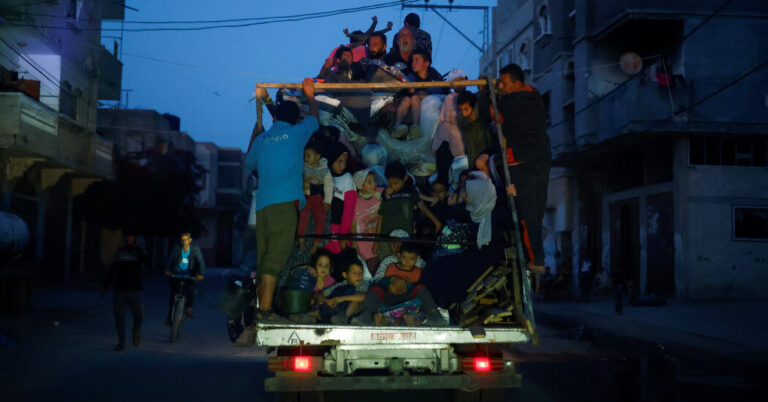Manal al-Wakeel and his extended family of 30 thought they were going home.
Displaced from their home in Gaza City months ago, Ms. al-Wakeel and her relatives began packing their bags on Monday and preparing to take down their tent in Rafah, on the southern edge of the Gaza Strip.
Hamas announced it had accepted a ceasefire proposal from Qatar and Egypt, leading many Gazans to believe a truce was imminent. Their joy was short-lived; it quickly became clear that Hamas was not talking about the same proposal approved days earlier by Israel, which claimed the two sides remained far apart.
Instead, Israeli warplanes dropped leaflets in eastern Rafah, calling on people to flee and move toward what Israel calls a humanitarian zone to the north, as the Israeli army bombarded the area. Gaza health authorities say dozens of people have been killed since the Israeli incursion into parts of Rafah this week.
“We thought that day that a ceasefire was possible,” said Ms. al-Wakeel, 48, who helped the humanitarian organization World Central Kitchen prepare hot meals.
She and her family were taking refuge near the Abu Yousef al-Najjar hospital, in an area affected by Israeli airstrikes and ground fighting. Hospital director Dr. Marwan al-Hams said Monday that he had received the bodies of 26 people killed by Israeli fire and treated another 50 wounded. The hospital was evacuated the next day.
So, rather than returning home, on Tuesday evening, Ms. al-Wakeel, her husband, her 11 children and other family members found a tractor-trailer that would take them away with their belongings, including suitcases of clothes, pots and tents, for $2,500. shekels – about $670 – looking for other accommodation.
They left Rafah around midnight and headed north with hundreds of tuk-tuks, trucks, cars and donkey carts filled with other displaced families and their belongings.
“It was a scary night, the truck was moving slowly because of the heavy load it was carrying,” she said.
Once outside Rafah, they stopped frequently in front of schools and other buildings, desperately looking for an empty place to shelter. But every place was full.
Others couldn’t find a place either, and Ms. al-Wakeel saw many people sleeping on the side of the road next to the belongings they had fled with.
At a United Nations school in Deir El-Balah, a young man suggested they stay in an empty concrete building – without windows – that belonged to the Hamas-led government’s Ministry of Social Development.
“It seemed like a dangerous place,” she said, adding that they were told that a woman and her daughter had previously been killed in one of the rooms of the building by an Israeli missile.
But they were too scared to continue wandering in the darkness and decided to spend the night there and look for a safer place in the morning.
“I feel so sad and disappointed about what happened in Rafah because the situation was stable for us there,” she said. “We have spent so much time making new places for ourselves and we feel depressed and exhausted from repeating the same suffering. »
Saeda al-Nemnem, 42, gave birth to twins less than a month before Israel dropped leaflets on where they were sheltering in Rafah, ordering them to leave. His family, also displaced from Gaza City, sent a relative to find a truck that could transport them north, despite intense Israeli airstrikes at the time.
Her relative, Mohammed al-Jojo, was killed by an Israeli strike on the tractor he was driving, she said.
He “was killed while he was taking us out of that area to a safer place,” she said. “I feel like I caused his death.”
Despite the dangers of the road, remaining where they were in Rafah was no safer.
During their terrifying journey to the town of Khan Younis, where she and her family of eight took shelter in a room adjoining the main building of Al Aqsa University, they could hear what sounded like explosions of Israeli bombs, missiles and artillery, she said.
“My children’s heartbeats were so high I could feel them,” she said. It was the most violent bombing she had ever heard, she said, “so close and so terrifying for me and my children.”


